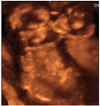Conjoined twins are extremely rare; approximately 1% of monochorionic twins are conjoined, with an estimated occurrence of 1:75,000.1 Most conjoined twins are aborted in early pregnancy and when given birth, approximately 40% are stillbirths, 35% are dead within 24 hours of birth, and only one in 250,000 is live birth.2,3 If twinning initiates after the embryonic disc and rudimentary amnionic sac have been formed,4 conjoined twins develop. Conjoined twins originate from an incomplete separation of the fetuses due to the delayed division of the inner cell mass after the formation of the embryonic disc,5 or from the fusion of already separated fetuses.6 Various types of conjoined twins exist, and they are classified according the point where their bodies join; thoracopagus and omphalopagus are the most common types. Although two-dimensional (2D) ultrasonographic diagnosis was made in the past, the development of three-dimensional (3D) ultrasound makes an early diagnosis of a variety of forms of conjoined twins more possible and accurate. We present a case of dicephalic thoraco-omphalopagus twins diagnosed in the early second trimester with transabdominal 2D sonography and 3D sonography.
Case Report
A healthy 19-year-old nulliparous woman was referred to our department at 14+2 weeks of gestation due to inconclusive findings on a previous ultrasound examination at a local clinic. She has no family history of multiple gestations. Transabdominal ultrasonography (Accuvix; Medison, Seoul, Korea) revealed a 14+2-week-old fetus with two normally shaped heads separated by two necks with separate spines, four upper and lower limbs, and one trunk with one heart (Fig. 1). The biparietal diameter was 2.55 cm and 2.60 cm, respectively, and the head circumference was 9.47 cm and 9.42 cm, respectively, and the femur length was 1.31 cm and 1.00 cm, respectively. The fetus had two stomachs (Fig. 2). Transabdominal 3D ultrasonography of the patient revealed thoraco-omphalopagus conjoined twins (Fig. 3). This patient followed up one week later, and we found that the conjoined twins' one heart had no cardiac activity under the ultrasonographic examination. Delivery was performed using two intravaginal cytotoecs (200 mg) and laminarias. The dead twins were joined from thorax to umbilicus. The heads, vertebral columns, genitalia and extremities were separate. Although the couple refused to give consent for postmortem autopsy, the external appearance of twins was exactly what we had anticipated on prenatal 2D and 3D ultrasonography.
DISCUSSION
Conjoined twins result from the division of the embryonic disc 13 days following conception. Twinning initiated after the formation of embryonic disc and the rudimentary amnionic sac causes an incomplete fission of the embryonic disc, thereby developing monochorionic monoamnionic twins. Obstetricians should emphasize the importance of diagnosing conjoined twins. Not only does ultrasonography help in diagnosing the conjunction of the twins, it also helps in defining the prognosis of conjoined twins by determining the degree of physical deformation of the joined fetus. The benefits of sonography during pregnancy include the detection of fetal anomalies and assessing the type of conjoining at certain stages of gestation. More importantly, early prenatal diagnosis of conjoined twins allows for better counseling of the patient and her family regarding management options. Although it is possible to diagnose conjoined twins in the first trimester, there is an increased false positive rate in cases before 10 weeks since fetal movement is limited earlier in gestation and monoamniotic twins may be mistaken for conjoined twins.7 Although the diagnosis of conjoined twins can be made at mid-pregnancy using 2D sonography, diagnosis using 3D sonography has become more prevalent.8 Pajkrt and Jauniaux7 concluded that 3D ultrasonography does not provide more accurate information than 2D sonography, and an early diagnosis of conjoined twins is also possible with 2D sonography, as Taner et al.9 recently reported a case of conjoined twins at about seven weeks of gestation.
On the other hand, Abu-Rustum and Adra10 recently reported a case of misdiagnosed pregnancy that was initially concluded as a missed abortion using 2D ultrasonography but was later revealed to be a conjoined fetus using 3D ultrasonography.10 In comparison, we were able to easily diagnose our case with 2D ultrasound and 3D ultrasound. 3D ultrasonography contributes to the antenatal diagnosis of conjoined twins and aids the physician in predicting the possibility of survival, surgical correction. Furthermore, it allows the parents to better understand the condition of the fetus. In this case, the diagnosis was made easily compared to other conjoined twins because two fetuses were sharing one heart and therefore it is readily recognized by the ultrasonography.
Knowing the various classifications of conjoined twins is a crucial step towards an accurate diagnosis that enables the obstetrician to advise a patient in making an informed decision. Conjoined twins are categorized based on the most prominent site of their union; these categories end with the suffix "pagus." a Greek word for "fixed." The most common is thoracopagus (joined thorax), which accounts for 30% to 40% of the cases, while omphalopagus (joined abdomen) accounts for 25 to 30% of the cases. Pygopagus (sacrum) is found in 10 to 20% of the cases, ischiopagus (pelvis) in 6 to 20% and craniopagus (head) in 2% to 16%.2,11
As two distinct heads, four arms, and four legs were found in each body whereas the thorax and abdomen were joined together, our case of conjoined twins were thus categorized as dicephalic thoraco-omphalopagus. Compared to other types of conjoined twins, thoracophagus-omphyalophagus have a good prognosis. However, in our case, the twins died in utero at about 16 weeks. The mother and father were aware of the conjoined twins, but wished to continue the pregnancy, which unfortunately ended with demise of the fetuses.
Assessing conjoined twins' structural integrity or malformations is important in order to completely understand the anomalies. The prognosis for conjoined twins is typically poor and as such, prenatal diagnosis of must be emphasized.




 PDF
PDF ePub
ePub Citation
Citation Print
Print





 XML Download
XML Download